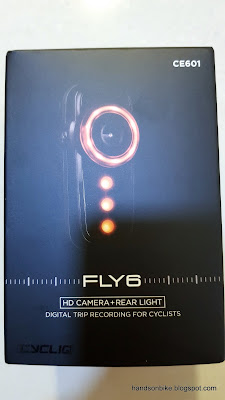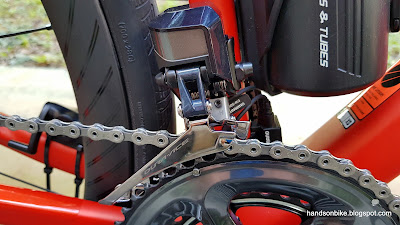Recently, the Fly 6 was updated again, to Fly 6 CE, which stands for Connected Edition. It can now be linked to the Garmin cycle computer, so that you can control the recording or the light modes from the computer. Not that I need it, as I don't think I need to change the mode on the go. However, what attracted me to the latest version is the upgraded video quality.
The previous versions had a video quality of HD, which is 720p. However, under less ideal lighting conditions, the video footage will become grainy and low quality. The new Fly 6 CE has increased the resolution to Full HD, 1920x1280p at 60 frames per second! This is excellent and it is my main reason to upgrade to the Fly 6 CE. For examples of video quality, just check out Youtube.
New all black design makes the light looks more sleek and less obtrusive.
New packaging
Similar layout, with the big camera lens on top and the LEDs below. The casing is now all black instead of red to blend in with the bike.
Power/mode button on the side
Brightness selection button on the other side.
The charging port (USB-C) is on top, right beside the Micro SD card slot. Covered by a rubber flap for rain resistance.
Instead of strapping the whole unit to the seatpost, it now attaches to a bracket via a twist type mount, similar to the Garmin type. The bracket remains on the bike.
Weighs 112 grams without the mounting hardware
Comes with a whole bunch of rubber shims, velcro strap and bracket to match almost any kind of seatpost.
Weighs 127 grams with one set of mounting.
Taking a closer look at the bracket, I found that it only works in one direction, as there is a stopper. No wonder I could only twist it in one direction instead of both directions like on the Garmin.
Installing and removing the fly 6 CE is easy, just twist it off like the Garmin.
Comparing the size to the previous version, the Fly 6 [v]. Much smaller in size as the mount is not part of the unit.
Much bigger lens on the new version!
Ring of red light around the lens, a signature design of the Fly 6.
The LEDs are really bright, and I find that using the low or medium brightness mode is sufficient.
For full HD recording at high FPS, a high performance micro SD card is necessary. This one is on Cycliq's list of recommended micro SD cards.
The camera and lights work well, and can be configured on the phone by downloading the app. However, the PC app does not work no matter what I try, luckily it works on the phone app.
Another issue is the poor quality of the velcro strap. It has a rubber coating for improved grip with the seatpost, but this layer of rubber peels off easily. Not a big issue as it can be solved by some DIY, just a little bit annoying that this is happening when it is new.
Black rubber layer peeling off the back of the velcro strap.
How it looks as mounted on the bike! All black look matches the bike well.
New bracket has a lower profile, which is good as it ensures that the VCLS seatpost can work properly without being constrained by the velcro strap.
For a super detailed review, refer to the one by DC Rainmaker, which is the benchmark for a good reviews with technical details and unbiased comments.

















































